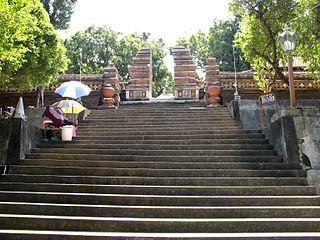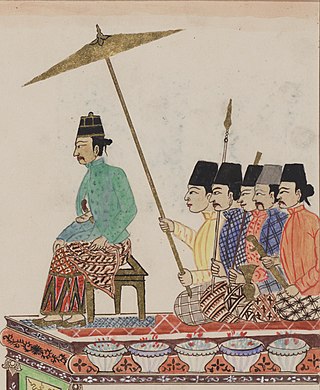
The Sultanate of Mataram was the last major independent Javanese kingdom on the island of Java before it was colonised by the Dutch. It was the dominant political force radiating from the interior of Central Java from the late 16th century until the beginning of the 18th century.

Imogiri is a royal graveyard complex in the Special Region of Yogyakarta, in south-central Java, Indonesia, as well as a subdistrict under the administration of Bantul Regency. Imogiri is a traditional resting place for the royalty of central Java, including many rulers of the Sultanate of Mataram and the current houses of Surakarta and Yogyakarta Sultanate. The name is Imagiri is derived from the Sanskrit Himagiri, which means 'mountain of snow'. The latter is another name for Himalaya.

Susuhunan, or in short version Sunan, is a title used by the monarchs of Mataram and then by the hereditary rulers of Surakarta, Indonesia.

The Sultanate of Yogyakarta is a Javanese monarchy in Yogyakarta Special Region, in the Republic of Indonesia. The current head of the sultanate is Hamengkubuwono X.

Hamengkubuwono I, born Raden Mas Sujana, was the first sultan of Yogyakarta. He reigned from 1755 to 1792.

Yogyakarta is the capital city of the Special Region of Yogyakarta in Indonesia, in the south-central part of the island of Java. As the only Indonesian royal city still ruled by a monarchy, Yogyakarta is regarded as an important centre for classical Javanese fine arts and culture such as ballet, batik textiles, drama, literature, music, poetry, silversmithing, visual arts, and wayang puppetry. Renowned as a centre of Indonesian education, Yogyakarta is home to a large student population and dozens of schools and universities, including Gadjah Mada University, the country's largest institute of higher education and one of its most prestigious.

Amangkurat I was the susuhunan of the Mataram Sultanate from 1646 to 1677.

Amangkurat II was the susuhunan of the Sultanate of Mataram from 1677 to 1703. Before taking the throne, he was the crown prince and had the title Pangeran Adipati Anom.

Blora is a regency in the northeastern part of Central Java province in Indonesia. Its capital is the town of Blora. The regency is located in the easternmost part of Central Java and borders the Bengawan Solo River and the East Java province. It covers an area of 1,955.83 km2 and it had a population of 829,728 at the 2010 Census and 884,333 at the 2020 Census; the official estimate as of mid-2023 was 901,621, comprising 450,993 males and 450,628 females.

The Royal Palace of Yogyakarta is a palace complex in the city of Yogyakarta, Yogyakarta Special Region, Indonesia. It is the seat of the reigning Sultan of Yogyakarta and his family. The complex is a center of Javanese culture and contains a museum displaying royal artifacts. It is guarded by the Yogyakarta Kraton Guards.

Mangkunegara II, also known as Prince Adipati Prangwedana I, Prince Surya Mataram, Prince Surya Mangkubumi, was the second ruler of Mangkunegaran in Java in the eighteenth century who succeeded to the throne of his grandfather, Mangkunegara I. His reign lasted from 1796 to 1835. Mangkunegara II was the son of Crown Prince Arya Prabumijaya I, who was the son of Mangkunegara I. Upon his death in 1835, he was the last male descendant Prince Sambernyawa to be named the Duke of Mangkunegaran.
Kangjeng Gusti Pangeran Adipati Arya Mangkunegara I, also known as Pangeran Sambernyawa, his birth name was Raden Mas Said, established the Puro Mangkunegaran, in Surakarta, Java Island. Thus, he was the first ruler of The Principality of Mangkunegaran.

Surakarta Sunanate is a Javanese monarchy centred in the city of Surakarta, in the province of Central Java, Indonesia.

The Java War of 1741 to 1743 was an armed struggle by a joint Chinese and Javanese army against the Dutch East India Company and pro-Dutch Javanese that took place in central and eastern Java. Ending in victory for the Dutch, the war led to the fall of the Sultanate of Mataram and, indirectly, the founding of both the Sunanate of Surakarta and the Sultanate of Yogyakarta.
Pakubuwono I, uncle of Amangkurat III of Mataram was a combatant for the succession of the Mataram dynasty, both as a co-belligerent during the Trunajaya rebellion, and the First Javanese War of Succession (1704–1707).

Amangkurat III was a short-lived susuhunan (ruler) of the Sultanate of Mataram, who reigned 1703–1705.
The Third Javanese War of Succession was an armed conflict from 1749 to 1757 on the island of Java. It led to the partition of the Mataram Sultanate into two and later three nominally independent 'Princely States': Surakarta, Yogyakarta and Mangkunegara.
The Javanese Wars of Succession were three military confrontations between the Dutch East India Company (VOC) and the Mataram Sultanate on central Java between 1703 and 1755. The hereditary succession in Maratam was at stake, prompting the VOC to field its own candidates in an attempt to gain more influence in central and eastern Java. At the end of the Javanese Wars of Succession, Mataram was carved into three weak Vorstenlanden, independent in name only, as a consequence of the divide and rule policy of the VOC.

Nicolaas Hartingh, was a Dutch colonial administrator for the Dutch East India Company (VOC). He served as Governor and Director of the northeast coast of Java from 1754 to 1761 and was appointed Full Counsellor of the Indies to the Vice-Roy's Council in 1765.

















